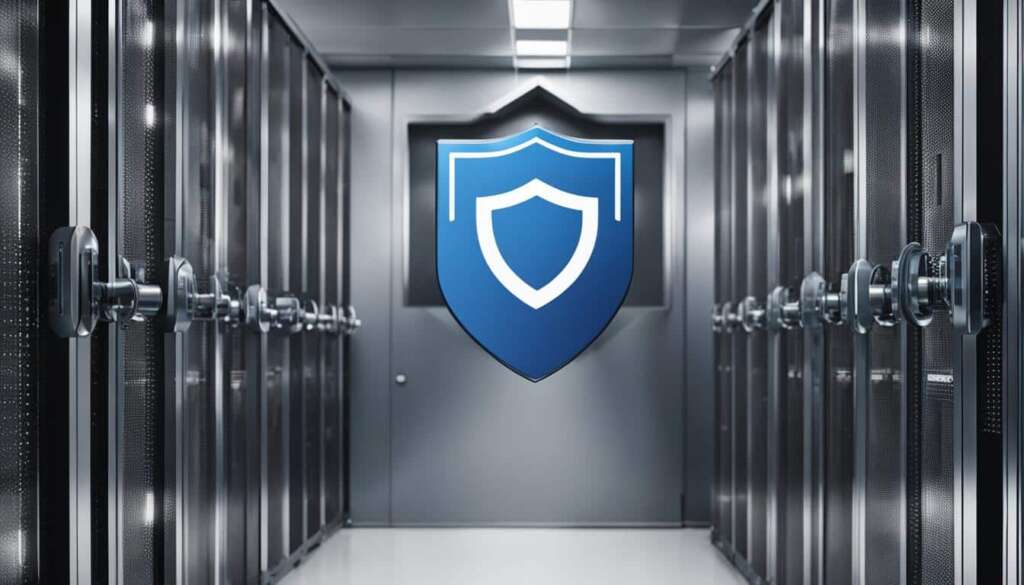Table of Contents
In today’s digital age, data security is of utmost importance. With the increasing threat of cyberattacks and unauthorized access, it is crucial to protect sensitive information stored on servers. Implementing secure server login measures ensures that only authorized individuals have access to valuable data. By prioritizing server security, businesses can safeguard their information, maintain data integrity, and comply with industry regulations.
When it comes to secure server login, several essential factors come into play. A robust login process, secure authentication methods, and proper security measures are key to establishing a secure environment. By adhering to best practices, organizations can minimize the risks associated with unauthorized access and data breaches.
One essential aspect of secure server login is the establishment of secure access to the login page. This involves implementing measures such as encryption, firewalls, and secure communication channels to protect login credentials from interception. By encrypting data transmission between the client and server, organizations can prevent unauthorized individuals from accessing sensitive information.
In addition to secure access, the login authentication process plays a vital role in server security. Implementing strong password policies, multi-factor authentication, and user identity verification protocols help ensure that only authorized individuals can log in to the system. By creating complex passwords that include a combination of letters, numbers, and symbols, organizations can significantly enhance login security.
Furthermore, organizations should consider implementing security measures such as intrusion detection systems, user activity monitoring, and regular security audits to maintain server login security. These measures help detect and prevent unauthorized access attempts, monitor user activity for suspicious behavior, and identify vulnerabilities that could compromise the server’s security. Regular software updates and patches are also crucial for mitigating security risks and ensuring that the server’s login process remains secure.
In conclusion, safeguarding your data with secure server login is essential in today’s cybersecurity landscape. By implementing secure access protocols, strong authentication methods, and robust security measures, businesses can protect their sensitive information from unauthorized access and potential data breaches. Investing in server login security measures is an investment in your organization’s reputation, compliance, and overall data protection.
Establishing Secure Server Connections
When connecting to a remote server, it is important to establish a secure channel for communication. This ensures that sensitive data remains protected from unauthorized access and interception. One of the most widely used protocols for secure server connections is the Secure Shell (SSH) Protocol.
SSH Protocol:
The SSH protocol provides a secure channel for remotely accessing servers. It encrypts all data transmitted during the session, making it inaccessible to anyone attempting to intercept communication over the network. This secure communication channel creates a safe environment for remote access and server management.
Enhancing Server Security:
In addition to using the SSH protocol, there are several measures that can further enhance server security. Changing the default SSH port number adds an extra layer of protection by making it harder for potential attackers to discover and target the server. Implementing SSH keys instead of password authentication also improves security as it eliminates the risk of password breaches or brute force attacks.
| Secure Server Connection Technologies | Description |
|---|---|
| File Transfer Protocol Secure (FTPS) | A secure extension of FTP that encrypts file transfers between a client and a server. It adds an extra layer of protection for transferring sensitive data. |
| Secure Socket Layer (SSL) | An encryption protocol used to establish a secure connection between a client and a server, commonly used for securing web communications and web administration areas. |
| Virtual Private Networks (VPNs) | VPNs provide a secure and private connection to remote servers. They create a virtual encrypted tunnel through which all data is transmitted, protecting it from unauthorized access. |
By implementing these secure server connection technologies, businesses and individuals can establish a robust security framework that safeguards sensitive data and ensures secure remote access to servers.
Protecting Against Brute Force Attacks
Preventing unauthorized access to secure server login is crucial for maintaining the integrity of your data. Brute force attacks, which involve repetitive login attempts using different combinations of usernames and passwords, can pose a significant threat to server security. However, there are several measures you can take to protect your server from such attacks.
Intrusion Prevention Software: Implementing intrusion prevention software can help monitor login attempts and block suspicious activity. This software uses advanced algorithms to detect patterns of brute force attacks and automatically prevent them from compromising your server.
Disabling Root User: Disabling the root user login for SSH is an effective way to mitigate risks. By creating a limited user account with sudo privileges, you can avoid granting attackers immediate access to critical server resources.
Password Requirements and Expiration: Setting strong password requirements, such as minimum length, complexity, and character combinations, can greatly enhance server security. Additionally, implementing password expiration policies ensures that passwords are regularly updated to minimize the risk of compromise.
Passphrases: Encourage users to create passphrases instead of simple passwords. Passphrases are longer and combine multiple words to create stronger authentication credentials.
Password Storage and Management: It is crucial to avoid storing passwords in plaintext or insecurely. Instead, consider using a password manager that encrypts and securely stores passwords in a centralized location.
Regular Software Updates: Keeping your server software up to date is essential for maintaining its security. Updates often include important security patches that address vulnerabilities and strengthen the overall server infrastructure.
By implementing these measures, you can significantly enhance the security of your server login and protect it against brute force attacks. Remember, prioritizing server security is key to safeguarding your data and maintaining the confidentiality of your information.

Ensuring Data Protection in OneDrive
OneDrive, a cloud storage service offered by Microsoft, provides a range of powerful features to ensure the security and protection of your data. By implementing these measures, you can have peace of mind knowing that your information is safe and secure.
Create a Strong Password
One of the first steps to protect your OneDrive account is to establish a strong password. Use a combination of uppercase and lowercase letters, numbers, and special characters, and avoid using common words or personal information that can be easily guessed.
Add Security Info and Enable Two-Factor Verification
To fortify the security of your OneDrive account, it is essential to add security information, such as an alternate email address or phone number. This additional layer of protection helps verify your identity in case you forget your password or encounter any other login issues.
Furthermore, enabling two-factor verification adds an extra level of security. With this feature, you need to provide a secondary form of authentication, such as a verification code or fingerprint, in addition to your password, to access your account.
Implement Encryption for Mobile Devices
Encrypting the data on your mobile devices adds an extra layer of protection in case your device is lost or stolen. By encrypting the data stored on your smartphone or tablet, you can prevent unauthorized access to your OneDrive files and ensure that your sensitive information remains secure.
Subscribe to Microsoft 365 for Advanced Protection
By subscribing to Microsoft 365, you gain access to advanced security features that provide enhanced protection against viruses and cybercrime. Microsoft 365 includes built-in virus scanning capabilities, ensuring that any files you upload to OneDrive are thoroughly checked for malware or other malicious content.
Safeguard Against Suspicious Activity
OneDrive monitors your account for any suspicious activity, such as unauthorized access attempts or unusual file modifications. This proactive monitoring helps identify and mitigate any potential security threats, ensuring the integrity of your data.
Utilize Version History for File Recovery
OneDrive offers a convenient version history feature that allows you to access and restore previous versions of your files. This can be particularly useful if you accidentally delete or make unwanted changes to a document, giving you the ability to revert back to a previous, unaltered version.
OneDrive provides the option to share files with others securely. You can protect shared links with passwords, ensuring that only authorized individuals can access the content. Additionally, you can set expiration dates for sharing links, limiting access after a certain period.
By following these best practices and utilizing the security features provided by OneDrive, you can ensure the protection and confidentiality of your data. Take advantage of these powerful tools and embrace the peace of mind that comes with knowing that your valuable information is secure in the cloud.
Conclusion
Maintaining a secure server login is paramount in protecting your sensitive data and ensuring the integrity, availability, and confidentiality of your server resources. By implementing robust measures such as secure communication channels, encryption, intrusion prevention software, and strong password security, you can significantly enhance your server’s security.
Regular software updates play a crucial role in keeping your server protected against emerging threats and vulnerabilities. It is essential to stay up-to-date with the latest security patches and fixes to prevent potential breaches. Additionally, utilizing secure cloud storage services like OneDrive adds an extra layer of protection to your data, safeguarding it from unauthorized access and ensuring its longevity.
Remember, data protection is a continuous process that requires vigilance and adherence to best practices. By following these guidelines and staying alert to any potential security risks, you can proactively defend your server against malicious attacks and potential data breaches. Investing in robust security measures is not only a practical necessity but also an essential aspect of maintaining the trust and confidence of your customers and clients.
FAQ
What is secure server login?
Secure server login refers to the process of accessing a server through a login page using secure authentication methods to protect sensitive data and ensure server security.
Why is secure server login important?
Secure server login is crucial for protecting sensitive data stored on servers from external threats. It helps maintain data integrity, availability, confidentiality, reputation, and compliance with industry regulations.
How can I establish a secure server connection?
To establish a secure server connection, you can use the Secure Shell (SSH) Protocol for encrypted communication, change the default SSH port number, and use SSH keys instead of passwords. Additionally, you can utilize File Transfer Protocol Secure (FTPS) and Secure Socket Layer (SSL) for secure file transfers and web administration areas. Virtual private networks (VPNs) can also provide secure and private connections to remote servers.
How can I protect against brute force attacks during server login?
To protect against brute force attacks, you can use intrusion prevention software that monitors login attempts and blocks suspicious activity. Disabling the root login for SSH, creating a limited user account with sudo privileges, setting password requirements and expiration dates, and using passphrases instead of passwords can also enhance server security.
What measures can I take to ensure data protection in OneDrive?
To ensure data protection in OneDrive, you can create a strong password, add security info to your Microsoft account, enable two-factor verification, and encrypt data on your mobile devices. Subscribing to Microsoft 365 provides advanced protection from viruses and cybercrime. OneDrive also offers virus scanning, suspicious activity monitoring, version history for file recovery, and additional security features such as password-protected and expiring sharing links.







